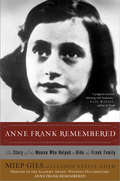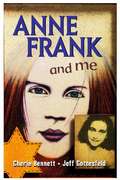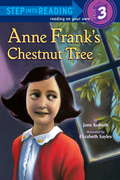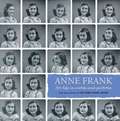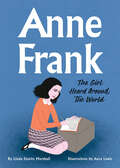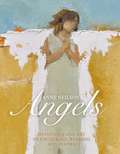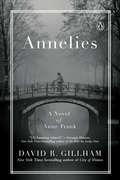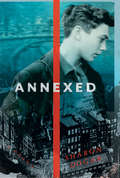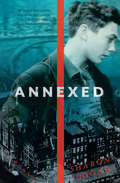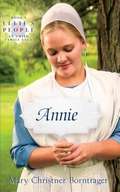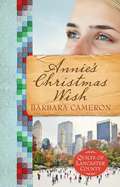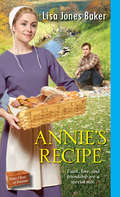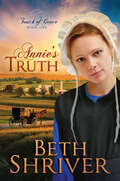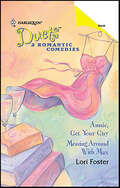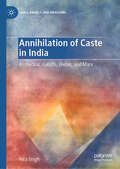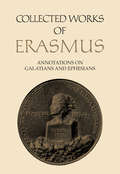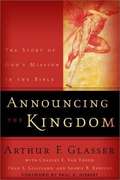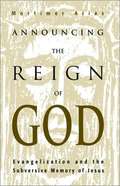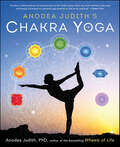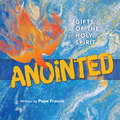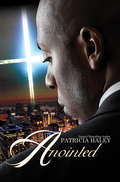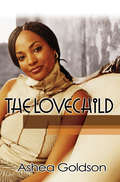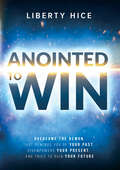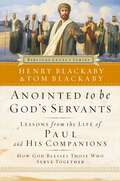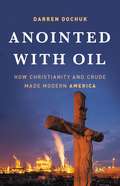- Table View
- List View
Anne Frank Remembered
by Miep Gies Alison Leslie GoldShe found the diary and brought the world a message of love and hope. It seems as if we are never far from Miep's thoughts....Yours, Anne For the millions moved by Anne Frank: The Diary of a Young Girl, here at last is Miep's own astonishing story. For more than two years, Miep Gies and her husband helped hide the Franks from the Nazis. Like thousands of unsung heroes of the Holocaust, they risked their lives each day to bring food, news, and emotional support to the victims. From her own remarkable childhood as a World War I refugee to the moment she places a small, red-orange, checkered diary -- Anne's legacy -- in Otto Frank's hands, Miep Gies remembers her days with simple honesty and shattering clarity. Each page rings with courage and heartbreaking beauty.
Anne Frank and Me
by Cherie Bennett Jeff GottesfeldKnocked unconscious after explosions ring out during a field trip to an Anne Frank exhibit, boy-crazy Nicole Burns wakes to find herself living a parallel life as a Jew in 1942 Paris. This Nicole is dating the boy of her present-day dreams, but living under the Nazis gradually becomes a nightmare. Her family survives the Nazi occupation with the help of friends, but when her father is exposed as a resistant, their fate takes a dire turn. The shifts in Nicole's lives--from a carefree, sophisticated Parisian girl to a wretch riding in a cattle car with Anne Frank; from a modern girl focused only on the drama of her high school life to a thoughtful observer of the potential of everyday injustices--will engage teens and change their views of history found in books and the history we're making today.
Anne Frank's Chestnut Tree (Step into Reading)
by Jane Kohuth Elizabeth SaylesHidden away in their Secret Annex in Amsterdam during World War II, Anne Frank and her family could not breathe fresh air or see the blue sky for years. But through an attic window Anne could see the branches of a tall chestnut tree. This small glimpse of nature gave Anne hope and courage. It inspired her writing, which, in turn, inspired the whole world. Jane Kohuth explores Anne Frank's strong belief in the healing power of nature in this Step 3 leveled reader biography for newly independent readers ages 5-8.
Anne Frank: Her Life in Words and Pictures from the Archives of the Anne Frank House
by Menno Metselaar Ruud van der Rol Arnold J. PomeransOn a summer day in 1942, Anne Frank and her family went into hiding from the Nazis. Until the day they arrested her, more than two years later, she kept a diary. ANNE FRANK is the indispensable visual guide to her tragic, but inspiring story. Produced in association with The Anne Frank House and filled with never-before-published snapshots, school pictures, and photos of the diary and the Secret Annex, this elegantly designed album is both a stand-alone introduction to Anne's life and a photographic companion to a classic of Holocaust literature.
Anne Frank: The Girl Heard Around the World
by Linda Elovitz MarshallAn evocative and accessible picture book about Anne Frank and how she found her voice in a world determined to silence her. All her life, Anne Frank wanted to be heard.Really, truly heard.Linda Elovitz Marshall introduces readers to the story of Anne Frank in this powerful book about family, war, and the importance of finding your voice.During her two years in hiding from the Nazis, Anne Frank poured her soul into a red plaid diary named Kitty. She wrote honestly of the reality of Nazi occupation, of daily life in the annex, and of her longing to be heard. More than anything, Anne spoke the truth, and her words have echoed throughout history.Gorgeous prose and striking art deliver Anne's ever-relevant story with poignancy and grace, while robust back matter -- including biographical information, an author's note, and a timeline -- makes this the perfect book for history curriculums.
Anne Neilson's Angels: Devotions and Art to Encourage, Refresh, and Inspire
by Anne NeilsonDo your heart and soul need encouragement, a new outlook and inspiration? Anne Neilson&’s Angels is an exquisite 40-day devotional from beloved artist, writer, and philanthropist Anne Neilson. Each section explores one word along with a new angel painting by Anne, a thoughtful definition, a Scripture reading and prayer, and two pages of Anne's reflections from her life that offer joy and comfort.Neilson's effervescent voice radiates through this one-of-a-kind devotional, which offers:Reflections on poignant topics such as love, abundance, release, identity, and purposeA sophisticated combination of 40 inspirational devotions alongside 40 original angel paintingsA stunning gift for a friend or family member, whether as a birthday, anniversary, or holiday gift, or as a unique housewarming presentThe art and devotions in Anne Neilson&’s Angels received praise from:Maria Shriver, Journalist, Author, Former First Lady of California – &“I have been a longtime fan of Anne&’s incredibly beautiful work. Her art transcends this earth and touches my soul. She is a true inspiration.&”Jenna Bush Hager, Co-host of the Fourth Hour of Today – &“A devotional book filled with radiant angels bringing hope and peace when we need it most. In these pages filled with Anne&’s beautiful art and words, you will find inspiration to live a more meaningful life.&”Roma Downey, Actress, Producer, Author – &“What a blessing this beautiful book of devotions from Anne Neilson is. Her writing and paintings speak beautifully to the soul. Each word is a gentle and wonderful reminder that angels are all around us, shining God&’s light on us and guiding us forward.&”Known for painting with both passion and purpose, Anne donates a portion of her book proceeds to those experiencing homelessness and poverty in our world, ensuring that Anne Neilson's Angels will continue to give back for years to come. Let Scripture, prayer, and the beauty of Anne Neilson's Angels nurture your soul.
Annelies: A Novel
by David R. GillhamA powerful and deeply humane new novel that asks the question: What if Anne Frank survived the Holocaust? The year is 1945, and Anne Frank is sixteen years old. Having survived the concentration camps, but lost her mother and sister, she reunites with her father, Pim, in newly liberated Amsterdam. But it’s not as easy to fit the pieces of their life back together. Anne is adrift, haunted by the ghosts of the horrors they experienced, while Pim is fixated on returning to normalcy. Her beloved diary has been lost, and her dreams of becoming a writer seem distant and pointless now. As Anne struggles to overcome the brutality of memory and build a new life for herself, she grapples with heartbreak, grief, and ultimately the freedom of forgiveness. A story of trauma and redemption, Annelies honors Anne Frank’s legacy as not only a symbol of hope and perseverance, but also a complex young woman of great ambition and heart. Anne Frank is a cultural icon whose diary painted a vivid picture of the Holocaust and made her an image of humanity in one of history’s darkest moments. But she was also a person—a precocious young girl with a rich inner life and tremendous skill as a writer. In this masterful new novel, David R. Gillham explores with breathtaking empathy the woman—and the writer—she might have become.
Annexed
by Sharon DogarEveryone knows about Anne Frank and her life hidden in the secret annex - but what about the boy who was also trapped there with her? In this powerful and gripping novel, Sharon Dogar explores what this might have been like from Peter's point of view. What was it like to be forced into hiding with Anne Frank, first to hate her and then to find yourself falling in love with her? Especially with your parents and her parents all watching almost everything you do together. To know you're being written about in Anne's diary, day after day? What's it like to start questioning your religion, wondering why simply being Jewish inspires such hatred and persecution? Or to just sit and wait and watch while others die, and wish you were fighting. As Peter and Anne become closer and closer in their confined quarters, how can they make sense of what they see happening around them? Anne's diary ends on August 4, 1944, but Peter's story takes us on, beyond their betrayal and into the Nazi death camps. He details with accuracy, clarity and compassion the reality of day to day survival in Auschwitz - and ultimately the horrific fates of the Annex's occupants.
Annexed
by Sharon DogarEveryone knows about Anne Frank and her life hidden in the secret annex but what about the boy who was also trapped there with her?In this powerful and gripping novel, Sharon Dogar explores what this might have been like from Peters point of view. What was it like to be forced into hiding with Anne Frank, first to hate her and then to find yourself falling in love with her? Especially with your parents and her parents all watching almost everything you do together. To know youre being written about in Annes diary, day after day? Whats it like to start questioning your religion, wondering why simply being Jewish inspires such hatred and persecution? Or to just sit and wait and watch while others die, and wish you were fighting.As Peter and Anne become closer and closer in their confined quarters, how can they make sense of what they see happening around them?Annes diary ends on August 4, 1944, but Peters story takes us on, beyond their betrayal and into the Nazi death camps. He details with accuracy, clarity and compassion the reality of day to day survival in Auschwitz and ultimately the horrific fates of the Annexs occupants.
Annie (Ellie's People Ser. #10)
by Mary Christner BorntragerAn Amish family opens their hearts and home to a deserted child, Pearlie Mae. They change her name to Annie and raise her in the Amish way. Annie keeps wondering if her birth mother will ever come back. She finds love and security with the Troyers, but not all is well. Lucy is jealous of the attention Annie receives. Annie runs to her mother's Leaning Tree and looks to God's Hills for help. Later Annie works for families as a baby-sitter and maid. She joins the Amish church and goes to youth singings. Boys keep asking to give her rides--till a beau declares himself. With compassion from the Amish community, Annie at last finds her own home. This book completes the Ellie's People series of ten popular volumes by Mary Christner Borntrager. All of them are available in the Bookshare library. Look for: #1. Ellie, #2. Rebecca, #3. Rachel, #4. Daniel, #5. Reuben, #6. Andy, #7. Polly, #8. Sarah and #9. Mandy.
Annie's Christmas Wish
by Barbara CameronEver since her step-mom brought her a snow globe of the New York City skyline, Annie has wanted to visit the beautiful, big city. Since it's nearing the time of Annie's rumschpringe--the time when Amish youth experience Englisch life to make a decision whether to live in that world or become baptized into the Amish faith--the family decides a visit is a good idea. They watch the Macy's Christmas parade, admire the decorated store windows, skate at the Rockefeller Center rink and-- Annie's favorite--get a glimpse of a writer's life while visiting the New York Times building. But others aren't as thrilled with Annie's lure to the Big Apple. Aaron has long been attracted to Annie and is sure he's in love. As he watches her engage in big city life, he grows concerned that she won't want to return to their quieter life. Will Annie follow Aaron back home? Or stay and pursue her dreams? Competing for her attention, Aaron sets out to show Annie that Christmas isn't about the glitz and glamour, but about family, love, and the birth of Jesus.
Annie's Recipe (Hope Chest of Dreams #2)
by Lisa Jones BakerThree young Amish women, each gifted with a hand-carved hope chest, find that one by one, with patience and faith, their most blessed dreams for the future can come true… Annie Mast and Levi Miller were best friends until his father was shunned by the church. Now, ten years later, Levi has returned to Arthur, Illinois, for a brief visit, and he and Annie discover their bond is as strong as ever. Spending as much time together as possible, Annie finds herself dreaming of a future with Levi. And Levi is soon dreaming of building a home on a beautiful local hillside—to live in with Annie. Yet their longings are unlikely to become reality… Levi is part of the English world, and while Annie cannot see herself there, she knows she must reveal her heart’s truth to him. And Levi, strongly reminded of his Amish roots, knows he must heal the bitterness of the past. And together, with love on their side, they just may find their way to an answered prayer…
Annie's Truth (Touch of Grace #1)
by Beth ShriverAfter learning the truth about who she really is, can this prodigal daughter be accepted back into the safety and security of home? Annie Beiler seems to have it all--a loving family in a tight-knit Amish community and the affections of an attractive and respected young man. But when she learns that she was adopted after being found as an abandoned newborn, she sets out on a journey to find out who she is. Her father is strongly against her decision to leave, as it could mean Meidung, or excommunication from the community and even her family. But Annie knows she must find &“the path that has her heart.&” As Annie&’s search brings her into the fast-paced world of modern life, she is confronted with all of the temptations she was warned of. Can she make her way back to the order and security of her family? Or will she remain an outsider, torn between her two worlds?
Annie, Get Your Guy and Messing Around With Max (Sawyer Family)
by Lori FosterIt's hard to get serious when your one and only won't take you seriouslyAnnie, Get Your GuyLori FosterWhat was a woman supposed to do?Guy Donovan had always treated Annie Sawyers like a little sister. But Annie already had a brother—what she wanted was a husband. Guy, to be precise! So when he announced his plans to get engaged—to the wrong woman! —Annie set out to seduce him. Which would have been a lot easier if Guy wasn't playing hard to get…Messing Around With MaxLori FosterHis love life was going to the dogs!Max Sawyers would do anything for his mangy, bad-tempered mutt, Cleo—he'd even give up his footloose lifestyle and take a wife. The trouble was, the only woman Cleo had ever taken a liking to was Maddie Montgomery. And Maddie was also the only woman on the planet who didn't want to snag Max permanently!
Annihilation of Caste in India: Ambedkar, Gandhi, Weber, and Marx (Marx, Engels, and Marxisms)
by Hira SinghThis book offers a critical re-examination of the relationship between caste and class. Singh demystifies caste based on a comparative analysis between a Weberian and Marxian understanding of power. He rejects Max Weber’s account of caste as rooted in culture which Weber saw as analytically distinct from the economic and political power. In contrast, Singh offers a Marxist analysis of caste as a matter of land (means of production) and labor (social relations of production). Extending his critique of the cultural understanding of caste, Singh examines one of the most prominent accounts of caste as a religious phenomenon specific to Hinduism. The book aims to show the intrinsic interconnectedness of class and caste.
Annotations on Galatians and Ephesians
by Desiderius Erasmus Riemer FaberVolume 58 in the Collected Works of Erasmus series contains, for the first time, the English translation of Erasmus’ Annotations on Paul’s Epistles to the Galatians and Ephesians. Erasmus’ Annotations began as marginal comments in his own copy of the New Testament and were subsequently published in 1516 as a supplement to the Novum Instrumentum. His annotations were intended to justify his changes based on the Greek text. In each successive edition, published between 1516 and 1535, the Annotations grew in size and scope providing Erasmus with the opportunity to defend his translations in the face of growing criticism from orthodox Catholic theologians. This volume notes the editorial changes made in the five editions and also provides the reader with information about the patristic, medieval and contemporary sources consulted by Erasmus, and about the evolving relations with contemporary critics. The Annotations played a pivotal role in the development of sixteenth-century biblical exegesis and mark a significant stage in the evolution of humanist biblical scholarship.
Announcing The Kingdom: The Story of God's Mission in the Bible
by Arthur F. Glasser Dean S. Gilliland Charles E. Van Engen Shawn B. RedfordAnnouncing the Kingdom provides a comprehensive survey of the biblical foundation of mission. It investigates the development of the kingdom of God theme in the Old Testament, describing what the concept tells us about God's mission in creation, the flood, and the covenant with Abraham. It then describes God's mission through the nation of Israel during the exodus, at Mt. Sinai, and through the kings of Israel. The book then examines God's mission as Israel is sent into exile and the stage is set for the Messiah's coming.
Announcing The Reign Of God: Evangelization And The Subversive Memory Of Jesus
by Mortimer AriasThis book offers a program for Christian evangelism based on the teachings of Jesus in Matthew, Mark, and Luke. This is a superb resource volume for those wishing to test the soundness of their understanding and practice of Christian evangelism. It is solidly grounded in the ministry of Jesus and illumined by testimonial statements and experiences drawn from a cosmopolitan variety of witnesses. . . <P><P>[Arias's] key contribution is the rehabilitation of the Kingdom of God as the controlling perspective for the proclamation of the gospel in word and deed. In a style helpful to scholar and nonscholar, he combs biblical sources, especially the Synoptic Gospels, in search of Jesus' own practice. The hermeneutical outlook is clearly dictated by Arias's own battle-tested experience in Bolivia, where he was bishop of the Methodist Church and where he underwent imprisonment as a consequence of his evangelistic practice. <P><P>After reading this book, dichotomies are inexcusable: - proclamation or social responsibility - intra-church or extra-church evangelization - the conversion of individuals or conversion of communities. [This book] should become at least a minor classic. --Jorge Lara-Braud, <P><P>Theology Today Chapter titles: The Good News of the Kingdom The Presence of the Kingdom The Imminence of the Kingdom The In-Breaking of the Kingdom The Eclipse of the Kingdom Announcing the Kingdom as Gift Announcing the Kingdom as Hope Announcing the Kingdom as Challenge End of the Eclipse? <P><P>Mortimer Arias was Methodist bishop in Boliva, Professor of Hispanic Studies and Evangelization at the School of Theology, Claremont, and a member of the World Council of Churches' Commission on world Mission and Evangelism. With his wife, Esther, he coauthored the popular book The Cry of My People.
Anodea Judith's Chakra Yoga
by Anodea JudithAs the architecture of the soul, the chakra system is the yoke of yoga—the means whereby mind and body, heaven and earth, and spirit and matter are joined together in the divine union that is the true meaning of yoga.In this long-awaited book by acclaimed chakra expert Anodea Judith, you will learn how to use yoga's principles and practices to awaken the subtle body of energy and connect with your highest source. Using seven vital keys to unlock your inner temple, you will be guided through practices that open and activate each chakra through postures, bioenergetic exercises, breathing practices, mantras, guided meditation, and yoga philosophy. With beautiful step-by-step photographs for each of the poses, along with guidelines for deeper alignment and activation of the energy body, this book is a valuable resource for teachers and students alike.Praise:"Anodea Judith's Chakra Yoga is a wonderful companion to her decades of books and teachings. Providing exploration through yogic methods for liberating, transforming, and balancing our energetic body and life, it is a gift to the world."—Shiva Rea, founder of Prana Vinyasa and author of Tending the Heart Fire"For decades, I have been waiting, wishing, longing for such a book as Anodea Judith's Chakra Yoga. As always with Anodea, the book is exquisitely presented, deep, practical, inspiring, easy to follow, contemporary. A MUST HAVE. Enjoy the ride!"—Margot Anand, author of The Art of Everyday Ecstasy
Anointed
by The Daughters of St. Paul Jaymie Stuart Wolfe Pope FrancisPope Francis’ words to those seeking to give a firm profession of faith—which has always been the particular effect Catholic tradition has ascribed to confirmation—ring true for all of us. In Anointed, Jayme Stuart Wolfe has compiled the Holy Father’s words about wisdom, understanding, counsel, fortitude, knowledge, piety, and fear of the Lord as special gifts for those continuing the commitment of their baptism into confirmation and beyond, as well as appropriate Scripture readings and prayers.
Anointed
by Patricia HaleyDave Mitchell is relishing the success of his start-up company, DMI. Success, however, has come at a tremendous price on the home front. The closeness he once shared with his wife of twelve years is gone. Dave spends most of his time working, while Madeline is struggling with balancing her job and home. When she elects to take time off and let Dave run the business, their lives are forever changed. Revered by others as a man of strong faith, Dave is not above temptation. His professional relationship with his new secretary eventually crosses the line, and the two share a night of passion. Madeline is crushed when she discovers the affair, but she has sacrificed too much already to let go. She digs her heels in, refusing to give up her marriage, her family, her company, or her place in Dave's heart.
Anointed
by Patricia HaleyDave Mitchell is relishing the success of his start-up company, DMI. His accomplishments, however, have come at a tremendous price on the home front. The closeness he once shared with his wife of twelve years is gone. Dave spends most of his time working, while Madeline is struggling with balancing her job and home. When she elects to take time off and let Dave run the business, their lives are forever changed.Revered by others as a man of strong faith, Dave is not above temptation. His professional relationship with his new secretary eventually crosses the line, and the two share a night of passion. Madeline is crushed when she discovers the affair, but she has sacrificed too much already to let go. She digs her heels in, refusing to give up her marriage, her family, her company, or her place in Dave's heart.Anointed is part of the Mitchell Family series. At the heart of the series is a family feud, bringing readers an explosive mix of sibling rivalry, marital discord, corporate intrigue, greed, faith, and a hint of romance.
Anointed to Win: Overcome the Demon That Reminds You of Your Past, Disempowers Your Present, and Tries to Ruin Your Future
by Liberty TurnipseedThere&’s a difference between failing and living in failure.This book will guide you to a life of true freedom and joy. Your mistakes and failures will no longer define who you are as you learn to embrace a refreshed life that can only be found in Jesus. You will be fully equipped to take authority over the enemy&’s attacks against you.Failurism. That may be an unfamiliar term, but it&’s a very real spirit that is keeping many Christians trapped in cycles of failure and defeat. Drawing from her personal experiences and revelations from Scripture, Liberty Turnipseed shows readers how to defeat the stronghold that hinders their success and tries to ruin their future. Through this book, readers will discover:the thought process created when we fail and how we allow ourselves to become bound to failurismhow the spirit of failurism manifests and how smaller demons infiltrate our lives and attach themselves to this strongholdhow the devil uses lies and deception to make failurism a way of lifehow to be set free from this demonic strongholdAs children of God, we may fail at times, but we don&’t have to continually walk in our past mistakes and make failure a lifestyle. We are anointed to win! This book provides the tools and understanding to walk in that victory.
Anointed to Be God's Servants: How God Blesses Those Who Serve Together (Biblical Legacy Series)
by Henry BlackabyIn Called to Be God's Leader, readers examined God's call for leadership through the life of Joshua. And now, in this fourth book in the Biblical Legacy Series, Drs. Henry and Tom Blackaby go behind the scenes of one of the Bible's greatest leaders in Anointed to Be God's Servants. Many people desire to be a "Joshua" but are called to serve in supporting positions. Through the life of Paul, readers will learn of the critical role that supporting companions play in God's kingdom. Why did Paul so desperately need companions? What does true companionship look like? How does Paul's life teach us to effectively support leaders around us? Anointed to Be God's Servants answers all of these questions and more, revealing the wonderful nature of interdependence in God's kingdom.
Anointed with Oil: How Christianity and Crude Made Modern America
by Darren DochukA groundbreaking new history of the United States, showing how Christian faith and the pursuit of petroleum fueled America's rise to global power and shaped today's political clashesAnointed with Oil places religion and oil at the center of American history. As prize-winning historian Darren Dochuk reveals, from the earliest discovery of oil in America during the Civil War, citizens saw oil as the nation's special blessing and its peculiar burden, the source of its prophetic mission in the world. Over the century that followed and down to the present day, the oil industry's leaders and its ordinary workers together fundamentally transformed American religion, business, and politics -- boosting America's ascent as the preeminent global power, giving shape to modern evangelical Christianity, fueling the rise of the Republican Right, and setting the terms for today's political and environmental debates. Ranging from the Civil War to the present, from West Texas to Saudi Arabia to the Alberta Tar Sands, and from oil-patch boomtowns to the White House, this is a sweeping, magisterial book that transforms how we understand our nation's history.
